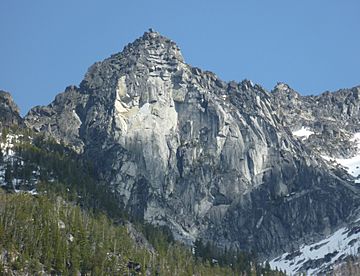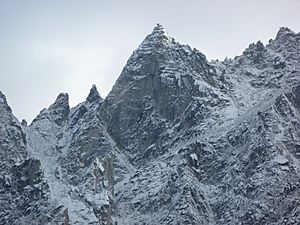Colchuck Balanced Rock facts for kids
Quick facts for kids Colchuck Balanced Rock |
|
|---|---|

Colchuck Balanced Rock from Colchuck Lake Trail
|
|
| Highest point | |
| Elevation | 8,200 ft (2,500 m) |
| Prominence | 160 ft (49 m) |
| Parent peak | Enchantment Peak 8520+ ft |
| Geography | |
| Parent range | Stuart Range Cascade Range |
| Topo map | USGS Enchantment Lakes |
| Type of rock | Granite |
| Climbing | |
| First ascent | 1958 by Gene Prater and Thomas Quin |
| Easiest route | Climbing |
Colchuck Balanced Rock is a cool mountain peak in Washington state. It stands about 8,200 feet (2,500 meters) tall. This mountain is made of a strong rock called granite.
You can find Colchuck Balanced Rock in Chelan County. It's part of a special area called The Enchantments, which is inside the Alpine Lakes Wilderness. This peak is also part of the Stuart Range, which is a smaller part of the huge Cascade Range.
Colchuck Balanced Rock sits west of Enchantment Peak. It's also east of Jabberwocky Tower and a beautiful place called Colchuck Lake. Rain and melting snow from the mountain flow into Colchuck Lake. This water then goes into Mountaineer Creek, which is a small river that joins Icicle Creek.
People who want to climb this mountain usually start on the Colchuck Lake Trail. From there, they walk away from Aasgard Pass. The mountain gets its name because its top looks like a pyramid with a big block resting on it. It looks like it's balancing, but it's actually settled firmly in place.
Contents
Weather Around Colchuck Balanced Rock
The weather in the mountains can be quite interesting! Most of the weather systems that affect this area start over the Pacific Ocean. They then travel east towards the Cascade Mountains.
When these weather systems hit the tall Cascade Mountains, they are forced to rise. As the air goes higher, it cools down. This causes the moisture in the air to turn into rain or snow. This process is called Orographic lift. Because of this, the Cascade Mountains get a lot of rain and especially a lot of snow, especially in winter.
During the winter, it's usually cloudy. But in the summer, big high-pressure systems form over the Pacific Ocean. These systems often bring clear skies and sunshine to the mountains. So, summers are usually sunny with few clouds.
How Colchuck Balanced Rock Formed
The Alpine Lakes Wilderness, where Colchuck Balanced Rock is located, has some very rugged land. You'll see sharp peaks, long ridges, and deep valleys carved by glaciers. There are also tall granite spires and more than 700 mountain lakes!
All these amazing features were created by geological events that happened millions of years ago. These events caused big changes in the land, leading to the tall mountains and deep valleys we see today.
The story of the Cascade Mountains began millions of years ago, during a time called the late Eocene Epoch. Back then, the North American Plate (a huge piece of Earth's crust) was slowly moving over the Pacific Plate. This movement caused many volcanic eruptions.
Also, small pieces of the Earth's crust, called terranes, crashed into North America. These collisions helped form the North Cascades about 50 million years ago.
Later, during the Pleistocene period (which started over two million years ago), huge sheets of ice called glaciers covered the land. These glaciers moved forward and then melted back many times. As they moved, they scraped and shaped the landscape, leaving behind piles of rock.
The last time the glaciers melted away from the Alpine Lakes area was about 14,000 years ago. By 10,000 years ago, they had moved north of the Canada–US border. The "U"-shaped valleys you see in the mountains were carved out by these powerful glaciers.
So, the tall peaks and deep valleys of the Alpine Lakes Wilderness were formed by a combination of the land pushing up (called uplift), cracks in the Earth's crust (called faulting), and the powerful work of glaciers.
Climbing Colchuck Balanced Rock
Colchuck Balanced Rock is a popular spot for rock climbing. Here are some of the climbing routes on the mountain:
- Colchuck Balanced Rock Col - This is a less difficult route, rated class 3.
- The Tipping Point - A challenging route, rated class 5.12, with 8 sections to climb.
- Let it Burn - Another tough route, rated class 5.12-, also with 8 sections.
- West Face - This route is rated class 5.11+ and has 9 sections.
- The Tempest - A very difficult route, rated class 5.12+, with 6 sections.
- Full Tilt (Tempest Wall Free Version) - Rated class 5.12, this route has 5 sections.
- The Scoop - A long route, rated class 5.11c, with 10 sections.
- Rikki Tikki Tavi - Rated class 5.11, this route has 5 sections.
- Leche La Vaca - This route is rated class 5.10 and has 4 sections.
Images for kids





